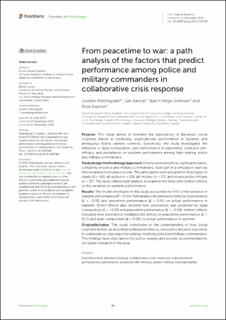| dc.contributor.author | Mattingsdal, Jostein | |
| dc.contributor.author | Aandal, Jan | |
| dc.contributor.author | Johnsen, Bjørn Helge | |
| dc.contributor.author | Espevik, Roar | |
| dc.date.accessioned | 2024-03-22T08:00:49Z | |
| dc.date.available | 2024-03-22T08:00:49Z | |
| dc.date.created | 2024-01-04T07:46:32Z | |
| dc.date.issued | 2023-12-22 | |
| dc.identifier.issn | 1664-1078 | |
| dc.identifier.uri | https://hdl.handle.net/11250/3123709 | |
| dc.description.abstract | Purpose: This study aimed to examine the applicability of Bandura’s social cognitive theory in predicting organizational performance in dynamic and ambiguous hybrid warfare contexts. Specifically, the study investigated the influence of dyad composition, past performance in peacetime, collective self-efficacy, and persistence on wartime performance among high-ranking police and military commanders.
Study design/methodology/approach: One hundred and thirty-eight participants, consisting of police and military commanders, took part in a simulation exercise that escalated from peace to war. The participants were assigned to three types of dyads (N = 69); all-police (n = 20), all-military (n = 27), and mixed police-military (n = 22). The study utilized path analysis to examine the direct and indirect effects of the variables on wartime performance.
Results: The model developed in this study accounted for 54% of the variance in wartime performance (R2 = 0.54). Path analysis showed direct effects of persistence (β = −0.33) and peacetime performance (β = 0.45) on actual performance in wartime. Direct effects also showed how persistence was predicted by dyad composition (β = −0.24) and peacetime performance (β = −0.50). Indirect effects indicated how persistence mediated the effects of peacetime performance (β = 0.17) and dyad composition (β = 0.08) on actual performance in wartime.
Originality/value: This study contributes to the understanding of how social cognitive factors, as described by Bandura’s theory, can predict decision outcomes in collaborative crisis response settings involving police and military commanders. The findings have implications for policy-making and provide recommendations for further research in this area. | en_US |
| dc.language.iso | eng | en_US |
| dc.publisher | Frontiers | en_US |
| dc.rights | Navngivelse 4.0 Internasjonal | * |
| dc.rights.uri | http://creativecommons.org/licenses/by/4.0/deed.no | * |
| dc.title | From peacetime to war: a path analysis of the factors that predict performance among police and military commanders in collaborative crisis response | en_US |
| dc.type | Journal article | en_US |
| dc.type | Peer reviewed | en_US |
| dc.description.version | publishedVersion | en_US |
| dc.rights.holder | Copyright 2023 the authors | en_US |
| dc.source.articlenumber | 1238760 | en_US |
| cristin.ispublished | true | |
| cristin.fulltext | original | |
| cristin.qualitycode | 1 | |
| dc.identifier.doi | 10.3389/fpsyg.2023.1238760 | |
| dc.identifier.cristin | 2220333 | |
| dc.source.journal | Frontiers in Psychology | en_US |
| dc.identifier.citation | Frontiers in Psychology. 2023, 14, 1238760. | en_US |
| dc.source.volume | 14 | en_US |

